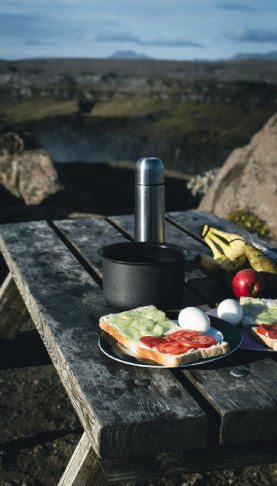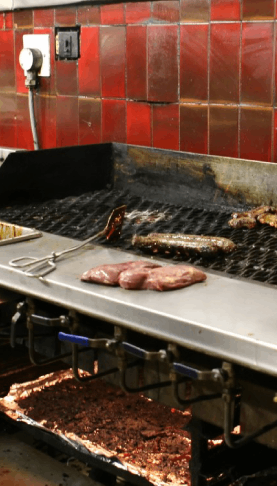If you want a lawn that feels clean and guest friendly for outdoor dining in Cape Girardeau, mow a bit higher than you think, keep blades sharp, schedule the cut 24 to 36 hours before people sit, and keep clippings off hard surfaces. That is the short version. If you do not want to DIY, here is a local option for lawn mowing Cape Girardeau. Now, let’s get into the details that matter when food and grass share the same space.
Why mowing choices change when food is involved
A lawn for lounging can forgive a few stray clippings. A lawn that seats people next to plates cannot.
Fresh cuts look neat, but the timing, height, and cleanup all touch the dining experience. You want clean shoes, calm noses, quiet surroundings, and fewer bugs. A good mow helps all of that, even if it seems minor at first glance.
Short grass near plates should not send dust, pollen, or clippings onto the food. That is the bar.
I learned this the awkward way. I once mowed the same morning before a small patio brunch. The lawn looked sharp. The toast did not. Grass confetti everywhere. Since then, I treat mowing like part of the menu planning. You probably do too, or you will after one windy omelet.
Know your Cape Girardeau grasses before you set the blade
Most lawns here use one of three types. Tall fescue is common on shaded lots. Zoysia and Bermuda show up on sunny, warm spots. Each one likes a different height, and that height changes how the lawn behaves around food.
Recommended heights for dining areas
| Grass type | Mowing height | How often in peak season | Notes for dining spaces |
|---|---|---|---|
| Tall fescue | 3.0 to 4.0 inches | Every 5 to 7 days | Mow higher for cooler soil and fewer weeds. Softer underfoot near tables. |
| Zoysia | 1.5 to 2.5 inches | Every 5 to 7 days | Dense, neat look. Bag clippings near the patio to avoid fine thatch on hard surfaces. |
| Bermuda | 1.0 to 2.0 inches | Every 4 to 6 days | Crisp, fast growth in heat. Needs sharp blades to avoid dust and frayed tips. |
If you do not know your grass, look at texture. Fescue blades are wider and deeper green, often thriving in part shade. Zoysia feels dense and slightly stiff. Bermuda is fine, fast, and loves full sun. When in doubt, set the deck a bit higher and test a small area. You can always lower it next pass.
Mow high for fescue near dining. Go lower for warm-season lawns, but not scalp-level. A clean cut beats a short cut every time.
Timing the mow around meals and service
This is the part most people skip, and it shows up on the table.
- Mow 24 to 36 hours before people dine outside.
- Blow and sweep hard surfaces right after the mow, then again the next morning.
- Skip same-day mowing. Wet clippings and scent can linger longer than you think.
- Water the day after mowing, early morning, not the evening before guests arrive.
Same-day cuts look fresh, but the scent of chlorophyll fights with food. Salads, wine, coffee, and grilled fish are more sensitive than burgers. Maybe you do not mind the smell. Guests might. Plan the mow like you would plan marination time. Not too soon, not too late.
If people will eat outdoors, aim to mow the day before, then let the lawn settle.
Blade sharpness, patterns, and why the small stuff matters
Dull blades tear grass. Torn grass dries at the tip and releases more tiny bits. Those bits become dust on plates and glasses. Sharp blades cut clean. The lawn looks darker and sheds less debris during dinner.
A quick checklist you can follow without overthinking it:
- Sharpen mower blades every 15 to 20 mowing hours in peak season.
- Check deck level front to back; a slight front drop helps cut clean.
- Skip aggressive striping next to seating if it means extra passes. One neat pass beats three show passes near people.
Patterns are nice for photos. Around dining, I think consistency is better than drama. Clean, even, quiet. That is the goal.
Edge control around patios, walkways, and grills
Edges make or break a dining setup. Overgrown edges shed clippings, which stick to damp shoes and then show up under chairs and on rugs.
- Use a blade edger or a trimmer held level, not angled.
- Keep a 2 to 3 inch buffer of mulch or stone around the patio to catch stray grass.
- Finish with a broom on pavers. A blower is fast, but a broom gets the last bits.
I like to run a second pass with the blower on low, away from the dining area, then do one slow walk with a push broom. It takes five minutes and saves thirty minutes of wiping chairs later.
Mulch or bag near food?
Both have a place. Mulching feeds the lawn and saves time. Bagging keeps small pieces off the patio. A mixed approach works well around seating.
- Mulch the bulk of the lawn.
- Bag the last two mower widths around the patio, grill, and buffet line.
- Empty the bag before it is half full to avoid trails.
Quick comparison
| Method | Pros | Cons | Best use near dining |
|---|---|---|---|
| Mulching | Feeds lawn, saves time | Fine bits on hard surfaces | Open lawn areas away from seating |
| Bagging | Cleaner edges, fewer stray clippings | More labor, disposal needed | Perimeter around patios and walkways |
Moisture, dew, and a dry cut
Water and mowing do not play well before dinner service. Wet grass gums up the deck, clumps badly, and sticks to shoes. It even tracks into indoor dining areas if you run back and forth with trays.
- Cut dry. Late morning or early afternoon is best once dew burns off.
- Do not irrigate the evening before people eat outside. Water the next morning instead.
- If rain is in the forecast, pull the mow forward by a day where you can.
Dry cuts also reduce the fresh-cut smell that can clash with food. That smell is pleasant until it fights a light white wine or a delicate dessert. I know I sound picky. You will taste the difference.
Allergy and scent control around food
Some guests react to pollen and fresh-cut volatiles. You cannot remove every trigger, but mowing a day early, cutting clean, and sweeping well lowers the load.
- Keep flowering weeds out of the seating zone. Clover attracts bees, which is nice for pollinators, not for bare ankles.
- Bag in spring when seed heads show on cool-season grasses.
- Skip scented cleaners on outdoor tables after mowing. Let the grass scent fade first.
When in doubt, move scented elements away from the lawn during service. Let the food carry the aroma, not the grass or cleaner.
Mowing height and pest pressure
Short grass around seating lowers tick risk and makes it easier to spot debris. Tall grass at the property edges can be fine for habitat. Just create a clean ring near people.
- Keep the first 6 to 10 feet around the patio at the recommended mowing height for your grass, no taller.
- Trim shrubs so leaves do not brush chairs. That is where mosquitoes like to hang in the shade.
- Remove thatch buildup that holds moisture, which can pull gnats into the zone.
I am not saying short everything. A layered look works. Lower near plates, fuller farther out. The eye reads it as tidy. So do ankles.
Fertilizer, color, and growth surges
Bright green sells the scene. Heavy feeding, though, creates fast growth, more clippings, and more dust right when people sit down.
- Use slow-release nitrogen for steady color, not a growth spike.
- If you plan a big gathering, avoid heavy feeding for 10 to 14 days before it.
- After the event, feed lightly and water in the morning.
You want the lawn to look good on the day, not explode the day after you cut it. That is the balance. No magic, just timing.
Weeds near patios: pre-emergent and spot control
Weed control is less about perfection and more about keeping seeds and prickly surfaces away from bare feet and plates.
- Apply a spring pre-emergent before soil warms. Follow the product label for timing by soil temperature, not the calendar.
- Hand-pull broadleaf weeds inside the dining ring. It takes minutes and looks better than a spray line.
- For cracks in pavers, brush sand back in after you remove growth.
Small weeds near chairs look bigger. People stare at them while they eat. Not great. A tidy edge makes even a simple setting feel well run.
Traffic, compaction, and chairs
Dining areas see foot traffic and chair legs. That compacts soil and flattens blades. Compaction shows up as thin spots and mud after a rain.
- Use chair pads or paver squares for the main seating zones on grass.
- Rotate table positions by a few feet each event.
- Consider core aeration once a year in the heavy-use lanes.
I used to skip chair pads. The lawn looked fine until the third party of the season. Then the footprints became bare spots. Small fix, big payoff.
Clipping control on gravel, pavers, and decks
Clippings on hard surfaces travel. Wind and shoes move them back over plates even after you think you cleaned them.
- Blow clippings with the wind away from dining. Then sweep across the grain of the surface.
- Rinse only after sweeping, not before. Wet clippings smear and stain.
- Keep a handheld brush near steps and chair legs for last touches.
I like a simple order. Blow, sweep, rinse. Then a quick walk with a towel for the stubborn bits. It sounds fussy. It is faster than re-wiping every glass.
Restaurant patio specifics
Homes and restaurants share the same basics, but service windows and foot traffic push standards higher for a public patio.
- Schedule mowing during closed hours or slow windows. Leave a 24 hour gap before patio service where you can.
- Bag within 15 to 20 feet of each table zone.
- Edge weekly during peak season. It keeps the ADA paths clear and cuts cleanup time.
- Post a simple sign if the surface is damp from morning dew or rinse water.
- Store salt, pepper, and napkins indoors until after mowing. They pick up dust fast.
One more small thing. Test the chair glide feet on your patio surface. If they catch clippings, switch to a smoother foot. It helps cleaning and reduces noise.
Simple gear that makes this easier
- Sharp-blade mower with a bagger attachment
- String trimmer and a blade edger for clean lines
- Hand broom and stiff push broom
- Battery blower for quiet cleanup near seating
- Moisture meter or just a screwdriver test for soil compaction
You do not need fancy tools. You do need the right ones when people eat ten feet away from the cut line.
Rain plan for mowing and meals
Rain shifts both cooking plans and mowing plans. Wet lawns tear easily and make a mess. Here is a simple pattern that keeps things on track.
- If rain is due on Friday and your event is Saturday, mow Wednesday.
- If an unexpected shower hits the morning of the event, skip any trimming and focus on sweeping and chair pads.
- When the lawn dries, mow at the regular time. Do not scalp to catch up.
I used to chase the perfect look after a storm. It was a mistake. Better to leave it slightly tall and clean than short and messy.
Kid zones, pets, and spill paths
Outdoor dining means movement. Kids run. Dogs circle the table. Spills happen in a straight line from grill to seat.
- Keep a wider mowed path from the kitchen door to the grill or pizza oven.
- Place a washable runner where the most traffic hits the grass.
- For pets, mow a touch lower along the fence line to reduce seed heads that stick to fur.
This also helps servers if you run a small patio service. Clear lanes move plates faster and safer.
Lighting, cords, and mower routes
String lights and temporary cables can catch mowers and trimmers. They also collect clippings. Plan the mow route before you set up decor.
- Hang cords high and tie slack. Keep them off the grass.
- Set lights after mowing where you can.
- Walk the route with the blower and look up, not just down. Cords hide in tree branches too.
Simple, I know. The one time you forget becomes the one time you cut power to the music as guests arrive. Ask me how I know.
Month-by-month lawn rhythm for Cape Girardeau
Dates shift with weather, but this rhythm works for most seasons here. Adjust up or down a week as needed.
| Month | Mowing focus | Dining zone notes |
|---|---|---|
| March | First sharp cut on dry days, clean edges | Blow and wash patio furniture before the first mow to avoid stains |
| April | Regular schedule begins, mow high for fescue | Bag during seed head flush near seating |
| May | Weekly or faster in warm sun | Mow 24 to 36 hours before weekend dining |
| June | Stay sharp on blades, trim light and often | Keep a clean two-pass ring around the patio |
| July | Watch drought stress, raise height for fescue | Water mornings after mowing, not nights |
| August | Control thatch and clippings, keep edges tight | Skip heavy fertilizer before events |
| September | Overseed fescue, keep traffic off new seed | Shift dining closer to hardscape while seed takes |
| October | Final tidy cuts, leaf control begins | Bag leaves and clippings near seating to prevent stains |
Leaf season and outdoor meals
Leaves in fall change the cleanup plan around food. Mulching leaves in open lawn is fine. Near the patio, bag or remove them. Wet leaf bits stick to everything and add tannin stains to pavers.
- Blow leaves away from the dining ring before mowing.
- Bag the final passes near hard surfaces.
- Finish with a dry sweep, then a light rinse if needed.
If you host often, build a permanent clean edge
Grass creeping onto pavers is a weekly battle. A small upgrade helps a lot:
- Install a steel or aluminum edging strip around the patio perimeter.
- Keep a 12 to 18 inch gravel or mulch border between grass and tables.
- Use a blower to pull debris into the border, then rake the border clean.
This gives you a place to hide the small stuff and keeps shoes cleaner during service.
What about reel mowers near dining spaces?
Reel mowers make very clean cuts on short warm-season lawns. They can be quieter, which is nice around restaurants. The trade-off is more frequent mowing and a smoother lawn surface requirement. If you run Bermuda or zoysia at lower heights and you host often, a reel can keep tips crisp and reduce dust. If your lawn is bumpy, a sharp rotary mower is easier to keep consistent.
A simple pre-service field check
Before guests arrive or the patio opens, take five minutes and walk the lawn like a server would walk the floor.
- Look for clippings on steps, chair legs, and under table bases.
- Shake out chair pads and wipe the bottom of chair feet.
- Check for low branches that brush heads or plates.
- Test that sprinklers are off and timers will not start mid-meal.
This quick loop catches what mowing and blowing miss. It also eases the mind right before service, which helps you focus on food.
Common mowing mistakes that show up on the plate
- Mowing the same day as dining, then wondering why glasses feel gritty.
- Cutting too low to make it look like a golf green, and kicking up dust.
- Skipping the second sweep on the patio. The first pass never gets it all.
- Watering at dusk, which draws mosquitoes into the seating zone.
- Ignoring chair traffic patterns, which turns routes into muddy streaks.
I have done all of these. Once. Twice in one case. After that, you adjust.
Quick hosting checklist you can save
- Set mower height for your grass. Err on the higher side near dining.
- Sharpen blade before peak season, touch up mid-season.
- Mow 24 to 36 hours before guests or patio service.
- Mulch the lawn, bag the last two passes around the patio.
- Blow, sweep, then rinse hard surfaces in that order.
- Place chair pads and a runner on main paths.
- Confirm irrigation off until morning after.
If you hire help
Whether you work with a crew or a local pro, share your hosting calendar. Ask for the cut a day before your event windows. Ask them to bag the last passes around the patio and to broom the pavers, not just blow them. Most crews will do this if you ask. Some will even set a standing note on your account. Simple alignment saves you from last-minute fixes.
A few food-first details that lawns influence
- Wine tastings: avoid fresh cuts that can mask aroma. Aim for two days before.
- Pizza nights: keep the path from oven to table extra clean. Bag the path edges.
- Seafood: control the grass scent and dust. Dry cut only, longer buffer from the table.
- Cocktails: keep garnish prep away from where you blew clippings. Move the bar kit indoors to prep.
These sound small. They are. They add up to a patio that feels cared for, which makes the meal feel cared for.
Final thought before you plan your next patio meal
People remember how a place feels. Lawn care is part of that feeling. Clean shoes. Calm air. Quiet background. If the lawn supports the food, guests focus on the plate and the conversation. You do not need perfect stripes or a magazine cover. You need a plan that is simple to repeat and leaves nothing on the table except what you meant to put there.
Questions and answers
Should I mow the morning of a cookout?
No. Mow the day before. Fresh cuts can throw scent, dust, and clippings onto plates and glasses.
What height should I set for tall fescue near a patio?
Keep it between 3.0 and 4.0 inches. Higher side in summer heat. That gives a soft feel and fewer stray bits.
Is bagging really necessary if I mulch?
Not everywhere. Bag only the last two passes around the patio and walkways. Mulch the rest. This keeps the edge clean without a full-bag job.
When should I water if guests are coming?
Water the morning after mowing, not the evening before dining. Dry turf stays cleaner and brings fewer bugs.
How do I keep clippings out of gravel dining lanes?
Cut with the discharge chute facing away from gravel. Then blow across the lane in one direction and finish with a stiff push broom. Rinse last.













